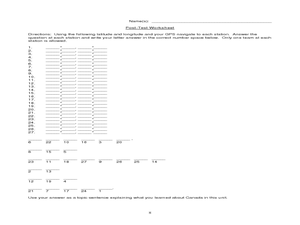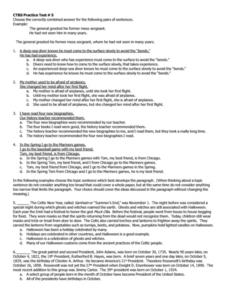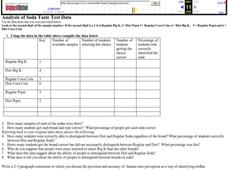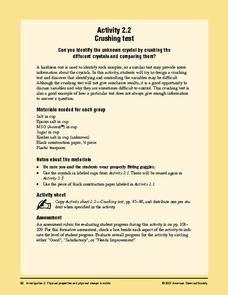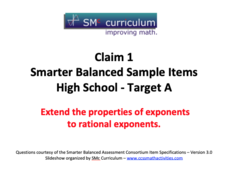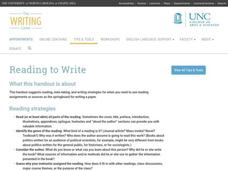Curated OER
Producing and Testing for Gases
In this gases worksheet, students conduct an experiment to produce 2 different gases and use standard tests to identify each gas. This worksheet has 14 short answer questions.
Curated OER
Working with Questions
Students explore questions in a scientific context. They consider what makes questions testable. After reading short scenarios, students come up with their own testable questions about the reading.
Curated OER
Beverage Tests
Students investigate the pH of a liquid. In this middle school mathematics/science lesson, students collect and analyze data regarding the pH of various liquids. Students display their data in various types of graphs as they...
Curated OER
Canada Eh? Pre/Post Tests on Canada Using GPS
Students participate in a GPS activity and answer questions about Canada. In this Canada lesson, students identify location by using a GPS Unit and latitude and longitude. Students find an Inuksuk (station) and a complete worksheet.
Curated OER
Algebra 2 Test
In this algebra worksheet, students solve problems by graphing inequalities, finding the slope of a line and identifying functions. This is a review of chapter 2 on an algebra test. There are 21 questions.
Curated OER
Algebra 2 Test
In this algebra worksheet, 11th graders test their knowledge of functions and slopes. They solve equations and identify functions, find the inverse and find the equation of parallel and perpendicular lines. There are 21 questions.
Curated OER
CTBS Practice Test #5
In this CTBS practice test, learners: condense two sentences into one, choose the correct topic sentence for a paragraph, and identify sentences that do not belong in a paragraph and simple subjects. Nineteen questions are asked.
Curated OER
Analysis of Soda Taste Test Data
In this analysis worksheet, students are given the raw date from a soda taste test experiment. Students use that data to complete a graphic organizer and to answer 8 questions.
Curated OER
Chapter 2 Test
In this algebra worksheet, students solve fractions, identify properties of numbers and solve 1 and 2 steps linear equations. There are 25 questions.
Curated OER
Grade 5: Testing for Tessellations
Fifth graders use formal geometric language to describe polygons (and other shapes) that will tessellate the plane and those that will not. Students make generalizations about the characteristics of a polygon (or other shape) that will...
Curated OER
Tests for Parallelograms Multiple Choice
In this parallelogram learning exercise, students examine the lengths of the sides of a quadrilateral. They identify parallelograms. This one-page learning exercise contains 13 multiple-choice problems. This online...
K5 Learning
The Parade
Parades are a joy to watch and learn about. Class members read about a child who attended a parade with her mother and brother, match past tense verbs from the reading, identify and fill in blanks for sight words candy,...
Curated OER
Atom Basics Test
Simple in format and standard in content, this resource is an assessment of your beginning chemists' grasp of the atom. Using a periodic table of elements, they fill in a chart of missing chemical formulas, atomic masses, and numbers of...
Curated OER
Matter Test
Physical science learners define matter, explain the law of conservation of matter, and identify compounds according to their state on this twenty-question test. Most appropriate for the introductory physical science class, this resource...
Curated OER
Solar Heat: Building and Testing a Solar Oven
Building a solar oven is always an enriching and engaging activity when your class is studying forms of energy or alternative and renewable energy sources. This lesson plan refers you to the re-energy.ca home website for specific...
American Chemical Society
Crushing Test
Solidify understanding of the properties of crystals by crushing them to compare hardness. After some class discussion, a procedure is planned, and then small groups go about making observations as they crush five different crystal...
Biology Junction
Scientific Method - Controls and Variables
Most teens like to sleep in as late as possible, so testing the fastest way to get to school sounds like a great idea. A presentation walks through how to identify the controls, independent variables, and dependent variables in setting...
PBS
Color Code
Don't let your brain play tricks on you! Learners test brain reaction rates while it is receiving multiple stimuli. They time each other reading a set of color words written in different colors and again when they are written in black....
Howard Hughes Medical Institute
Scientific Inquiry Using WildCam Gorongosa
How do scientists determine what questions to ask to meet their research goals? Help your class develop an inquiry mindset with a lesson based on studies in the Gorongosa National Park. Partners create their own research questions by...
It's About Time
Refraction of Light
Don't shine like a diamond, refract light like a diamond. Young scientists use an acrylic block and a laser light to observe refraction. Advanced scholars figure the sine of the angles of reflection and incidence as well as mastering...
Scholastic
Study Jams! Function Tables
Each week Mia saves a certain portion of the earnings from her babysitting job. Help her figure out how much she can save this week with a step-by-step presentation on function tables. Given a set of inputs and outputs, the process for...
CCSS Math Activities
Smarter Balanced Sample Items: High School Math – Target A
Don't get irrational about rational exponents. A PowerPoint presentation highlights the sample high school questions from the Smarter Balanced Assessment Consortium (SBAC) Claim 1 Target A item specifications. As one part of a larger...
University of North Carolina
Reading to Write
Silly journal and essay prompts may be fun to write, but they don't model the kind of writing needed for college papers and standardized tests. The 15th part in a series of 24 covers the concept of reading to write—during and after...
California Academy of Science
The Heat is On: Cause and Effect and Climate
The higher the number of letters in the final word for the National Spelling Bee, the higher the number of people killed by venomous spiders. Obviously, those two facts correlate, but no causation exists. Scholars view data based on...



